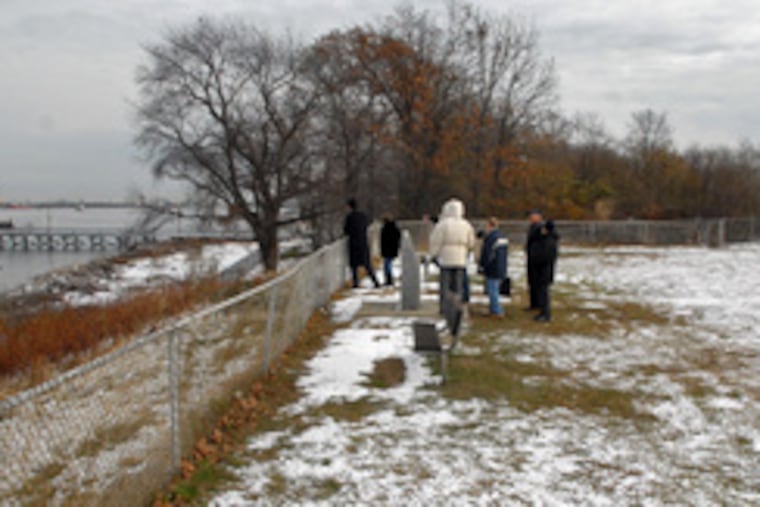Fighting to save remains of a fort
Paulsboro is home to a key military installation from the Revolutionary War.

Somewhere in the ground overlooking the Delaware River, amid the trees and brush at a Paulsboro oil-storage terminal, is a long-forgotten piece of American history.
Identified on a British map 230 years ago as a "rebel fort," the site was the nation's first federal land purchase, made the day after the Declaration of Independence.
It's the "birthplace of homeland security," says a group of local historians, preservationists and municipal officials who hope to restore the fort as a national historic site.
They hope to uncover its earthen walls - and possibly a few brick or stone tunnels - as well as artifacts such as cannon and musket balls and other relics.
But their plans have hit a snag.
Fort Billingsport, which held off British ships for about a month in 1777, seems poised for another battle, this one over historic preservation.
The owner of the property, Pacific Atlantic Terminals L.L.C., has not allowed private archaeological access to the secured location, the local group says, and has not returned its calls or letters in months.
What's more, Pacific Atlantic is planning to expand its facilities near the fort site.
The company, a subsidiary of Plains All American Pipeline L.P. in Houston, issued a brief statement last week concerning its plans for the land, which is encircled by a fence topped with barbed wire.
"A third-party survey of the property has been conducted, and Pacific Atlantic Terminals L.L.C.'s Paulsboro terminal expansion does not encroach on the site where the earthen fortification is thought to have existed," said the company, which did not respond to requests for additional information.
The state plans to double-check that assessment. The Department of Environmental Protection's land-use division this month asked the agency's Historic Preservation Office to review the permit request for the expansion, DEP spokeswoman Darlene Yuhas said.
The office can order an archaeological survey if officials find a site has historical value.
Walter Quint, an assistant professor at Rowan University and a former Paulsboro school superintendent who is leading local preservation efforts, describes the fort, on roughly three acres, as "an extremely significant piece of land.
"Think about what happened on July 4, 1776, and then what happened the next morning. [The Continental] Congress' next act was securing the then-capital of Philadelphia. So the fort has a unique status," Quint said.
The state has listed a public tract, called Fort Billings Park, on its New Jersey Register of Historic Places. At the end of Delaware Street overlooking the river, it includes plaques memorializing the fort and honoring its designer and two soldiers who evacuated it in the face of a large British force.
A few feet away, Pacific Atlantic land believed to be the fort's location has been surveyed a few times over the years. The most recent survey, in 2006, revealed a depression in the ground about the size and shape of the fort's foundation, Quint said. The outline of the fort on a British map from 1777 generally matches the shape, he said.
Vincent Maresca, an archaeologist for the New Jersey Historic Preservation Office, said a historic preservation officer would review the terminal's expansion project and "can request an archaeological survey if it's determined there's a high potential for archaeological resources."
The fort was purchased for 600 pounds on July 5, 1776, and built on 96 acres of the Billingsport section of Paulsboro, said Quint, chairman of the Fort Billingsport Homeland Security Committee, a group of residents seeking to restore the site.
He said George Washington commissioned the Polish military engineer Thaddeus Kosciuszko to design a fortification that could stop British ships from reaching Philadelphia. Kosciuszko, whose abilities were admired by Washington and Thomas Jefferson, also helped design defenses at Philadelphia, Saratoga and West Point.
"Fort Billingsport was Kosciuszko's first job," said Quint, who lives in West Deptford. "His real genius was in the location. . . .
"It's at a perfect place. It was at the narrowest point of the river with a commanding view on a high piece of land about 30 to 40 feet above the Delaware."
The fort was built by New Jersey, Pennsylvania, Virginia and South Carolina troops and inspected by Washington on Aug. 1, 1777. The Americans trained cannon on the river, had a small navy of armed vessels, and embedded chevaux-de-frise - long iron-tipped poles - in the Delaware to pierce the bottoms of enemy vessels.
"They blockaded the river and slowed down the British ships," Quint said. "It took [the British] about a month to get past the fort. They sent a force of 1,500 troops by land, and the fort's defenders evacuated in a hurry."
Efforts to investigate the site stalled last summer, said members of the Fort Billings Homeland Security Committee, after the Paulsboro Planning Board approved expansion of the facility.
"Public access is needed to recreate the fort," Paulsboro Mayor John J. Burzichelli said. "We have to work through the security concerns, buffering the fort from the tank farm.
"We want people to be able to visit the site. This is an important page in America's early history, and we want to reclaim it so people can see it, not just talk about it."
Looking over the wooded tract, Quint summed up his group's feelings. "It's just a little piece of land, but it has tremendous historic significance. Frankly, it's a matter of pride for Paulsboro."